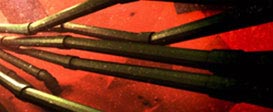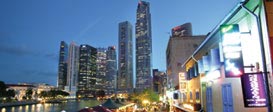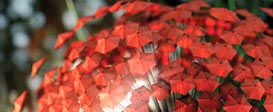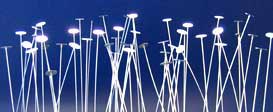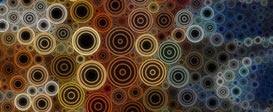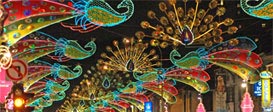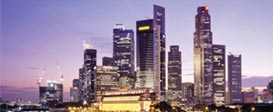Technical Papers Fact Sheet
Conference: Wednesday 10 December - Saturday 13 December
Exhibition: Thursday 11 December - Saturday 13 December
The Facts
- The SIGGRAPH Asia 2008 Technical Papers programme is a premier international forum for disseminating important and provocative new work in computer graphics and interactive techniques.
- The Technical Papers programme received a total of 320 submissions, from which 59 were selected for publication. This is an acceptance rate of 18.4 percent, which is slightly lower than the SIGGRAPH 10-year average of 19.3 percent.
- SIGGRAPH Asia 2008 will feature 59 accepted papers, and authors hail from some 60 academic institutions in a dozen countries, including the Massachusetts Institute of Technology, Harvard, Hong Kong University of Technology, Stanford, Princeton, and Purdue University. The papers will also be published in a special issue of ACM Transactions on Graphics. They span the core areas of modelling, animation, imaging, and rendering, and many papers span multiple categories to explore, for example: using an image to derive geometric information or using images to drive animations. There is also a strong emphasis on use of graphics hardware (GPUs).
- Technical Papers submissions came from Asia (30 percent), Europe (20 percent) and the United States (50 percent).
A Quote from the SIGGRAPH Asia 2008 Technical Papers Chair:
"Our goal for the Technical Papers programme was simple: to establish a second annual international programme with quality and importance equal to that of SIGGRAPH. With the strong support we have received from the graphics technical community, my programme committee and I are confident that we have achieved that goal for SIGGRAPH Asia 2008."
SIGGRAPH Asia 2008 Technical Papers Programme highlights include:
Fast Image/Video Upsampling
People are familiar with upsampling DVD players that attempt to improve the image quality of DVDs to approach HDTV quality. This paper describes an iterative approach that is practical to implement, is roughly invariant to the source imagery, and works for video (meaning that it is stable from frame to frame, instead of causing visible "jumps" or "flashes" in the video sequence). This is a simple yet effective upsampling method for automatically enhancing image/video resolution, while naturally preserving the structural information and temporal coherence.
Qi Shan
Zhaorong Li
Jiaya Jia
The Chinese University of Hong Kong
Chi-Keung Tang
Hong Kong University of Science & Technology
Deep Photo: Model-Based Photograph Enhancement and Viewing
A novel method for browsing, enhancing, and manipulating outdoor photographs by combining them with existing geo-referenced digital terrain and urban models. The method uses terrain models (say, from Google or Microsoft) to allow a photograph of the terrain to be enhanced in ways that are otherwise very difficult. A user registers the terrain model with the photograph, then it's easy to generate effects such as dehazing, relighting, and adding overlay text.
Johannes Kopf
Universität Konstanz
Dani Lischinski
The Hebrew University
Daniel Cohen-Or
Tel Aviv University
Boris Neubert
Oliver Deussen
Universität Konstanz
Michael Cohen
Matt Uyttendaele
Microsoft Research
Billy Chen
Microsoft Research
Laughing Out Loud: Control for Modelling Anatomically Inspired Laughter Using Audio
A novel technique for generating animation of laughter, including an audio-controlled method that automatically creates an animation from a soundtrack of an individual laughing.
Paul DiLorenzo
Victor Zordan
Benjamin Sanders
University of California, Riverside
Papers With Application in Television and Movies
VirtualStudio2Go: Digital Video Composition for Real Environments
Synchronised film cameras, video projectors, and high-speed LED lighting, together with radiometric image correction, enable professional digital video composition effects in real environments without the constraints of virtual studios.
Anselm Grundhoefer
Oliver Bimber
Bauhaus Universität Weimar
Intrinsic Colorization
An example-based colorisation technique robust to illumination differences between grayscale target and color-reference images.
Xiaopei Liu
Liang Wan
Yingge Qu
Tien-Tsin Wong
Pheng-Ann Heng
The Chinese University of Hong Kong
Stephen Lin
Microsoft Research Asia
Chi-Sing Leung
City University of Hong Kong
Papers With Application for Improved Illustrations
Richness-Preserving Manga Screening
A novel method for screening manga-style drawings from photographs, by preserving the tone similarity, texture similarity, and chromaticity distinguishability.
Yingge Qu
Wai-Man Pang
Tien-Tsin Wong
Pheng-Ann Heng
The Chinese University of Hong Kong
Line-Art Illustration of Dynamic and Spectacular Surfaces
A real-time rendering system that can illustrate dynamic 3D models in line-art styles. The system can also illustrate reflections and refractions on specular surfaces.
Yongjin Kim
Pohang University of Science & Technology
Jingyi Yu
Xuan Yu
University of Delaware
Seungyong Lee
Pohang University of Science & Technology
Adaptive Cutaways for Comprehensible Rendering of Polygonal Scenes
Generating cutaway renderings of polygonal models at interactive frame rates, using illustrative and non-photorealistic rendering cues to expose objects of interest in the context of nearby and enclosing objects
Michael Burns
Adam Finkelstein
Princeton University
Demarcating Curves for Shape Illustration
This paper defines a new class of view-independent curves (demarcating curves) and proves relations between them and other well-known curves. Their application to archaeological artifact illustration is demonstrated.
Michael Kolomenkin
Technion - Israel Institute of Technology
Ilan Shimshoni
University of Haifa
Ayellet Tal
Technion - Israel Institute of Technology

